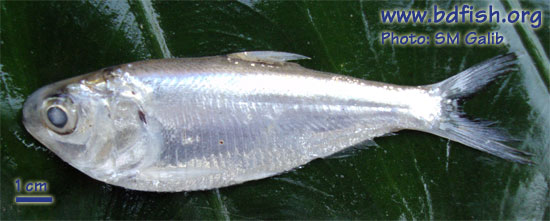
শ্রেণীতাত্ত্বিক অবস্থান (Systematic position):
পর্ব: Chordata
শ্রেণী: Actinopterygii (Ray-finned fishes)
বর্গ: Clupeiformes (Herrings)
উপবর্গ: Clupeoidei
পরিবার: Clupeidae (Herrings, shads, sprats, sardines, pilchards, and menhadens)
উপপরিবার: Alosinae (Shads)
গণ: Gudusia
প্রজাতি: Gudusia chapra
সমনাম (Synonyms):
Alausa microlepis Valenciennes, 1847
Clupanodon cagius Hamilton, 1822
Clupanodon chapra Hamilton, 1822
Clupea champil Gray, 1834
Clupea chapra (Hamilton, 1822)
Clupea indica Gray, 1834
Clupea suhia Chaudhuri, 1912
Gudusia godanahiai Srivastava, 1968
সাধারণ নাম (Common name):
ইংরেজি: Indian river shad
বাংলা: বাংলাদেশে এটি চাপিলা ও খয়রা এবং ভারতের পশ্চিম বঙ্গে চোরি, খিরা ও খইরা নামে পরিচিত।
অন্যান্য: এই মাছ ভারতের আসামে করোটি ও ক্যারাটি; বিহার ও উত্তর প্রদেশে সুইয়া ও সুহিয়া; পাঞ্জাবে চাপ্পেরা, ফারান্দা ও পাল্লা; ওড়িশায় গুডুয়া নামে পরিচিত (Talwar and Jhingran, 1991)।
বিস্তৃতি (Distribution):
বাংলাদেশ এবং ভারতে এদের সবচেয়ে বেশি পাওয়া যায় (Talwar and Jhingran, 1991)। এছাড়াও নেপাল, পাকিস্তান ও মায়ানমারেও এদের উপস্থিতির তথ্য রয়েছে।
সংরক্ষণ অবস্থা (Conservation status):
আইইউসিএন বাংলাদেশের (IUCN Bangladesh, 2000) মতে এটি হুমকিগ্রস্ত প্রজাতির নয়।
দৈহিক গঠন (Morphology):
পার্শ্বীয়ভাবে অত্যধিক চাপা এই মাছের অঙ্কীয় দিক সবচেয়ে বেশি চাপা। আদর্শ দৈর্ঘ্য দেহের উচ্চতার ২.৬-৩.২ গুণ। উদর জুড়ে ২৬-২৯ টি স্কিউট (Scute) দেখতে পাওয়া যায়। (Talwar and Jhingran, 1991)। পার্শ্বরেখা বরাবর ৮০-১১০ টি (Bhuiyan, 1964), ৮৫-১০৫ টি (Rahman, 1989 and 2005), ৭৭-৯১ টি (Talwar and Jhingran, 1991) আঁইশ বর্তমান।
দেহের পৃষ্ঠদেশ বাদামী ও পার্শ্বদেশ রূপালী বা সোনালী বর্ণের। কানকুয়ার পৃষ্ঠ-পশ্চাৎ কোণে অনিয়মিত আকারের একটি কালো দাগ উপস্থিত। এছাড়াও বেশিরভাগ ক্ষেত্রেই উল্লেখিত দাগটির পরেই পৃষ্ঠদেশ বরাবর একসারিতে অনেকগুলো অনিয়মিত আকারের কালো দাগ দেখতে পাওয়া যায় যা পশ্চাৎদেশ পর্যন্ত বিস্তৃত।
পাখনা সূত্র (Fin formula):
D. 14-16; A. 21-25; P. 13; V. 8; C. 19 (Bhuiyan, 1964)
D. 14-15 (3/11-12); P1. 13 (1/12); P2. 7; A. 23-25 (2/21-23) (Rahman, 1989 and 2005)
D iv 11-13; A (ii) iii 19-22; P i 12-13; V i 7 (Talwar and Jhingran, 1991)
D. 17; P. 15; V. 9; A. 18-21; C. 19 (Shafi and Quddus, 2001)
সর্বোচ্চ দৈর্ঘ্য (Maximum length):
সর্বোচ্চ মোট দৈর্ঘ্য এটি ১৪ সেমি (Bhuiyan, 1964), ২০ সেমি (Rahman, 1989 and 2005) এবং সর্বোচ্চ আদর্শ দৈর্ঘ্য ১৫ সেমি (Talwar and Jhingran, 1991)।
আবাস্থল (Habitat):
চাপিলা মাছ নদীতে বসবাস করে (Talwar and Jhingran, 1991)। বাংলাদেশের নদী (পদ্মা ও যমুনা) ও ঝরনায় সবচেয়ে বেশি দেখতে পাওয়া যায় তবে পুকুর, ডোবা, বিল, খাদ ও প্লাবনভূমিতেও এদের পাওয়া যায় (Rahman, 1989 and 2005)। বর্ষাকালে এরা এদের আবাসস্থল থেকে বিল ও ঝিলে অভিপ্রয়াণ করে (Bhuiyan, 1964)। উপকূলীয় এলাকার নোনাজলে (brackish) এমনকি বঙ্গোপসাগরেও এদের দেখা মেলে।
খাদ্য এবং খাদ্যাভ্যাস (Food and feeding habit):
জলাশয়ের উপরিস্তরের খাবার খেয়ে থাকে (Bhuiyan, 1964; Rahman, 1989 and 2005)।
প্রজনন (Reproduction):
এদের স্ত্রী ও পুরুষ আলাদা তবে বাহ্যিক বৈশিষ্ট্য দেখে এদের আলাদা করা কঠিন। নিষেক দেহের বাহিরে ঘটে। স্বাদুপানিতে মূলত বর্ষাকালে এরা প্রজননে অংশ নেয়। পরম ডিম্বধারণ ক্ষমতা (Absolute Fecundity) ১০৮০০-৩৬২০০ (Hossain et al.)
মৎস্য গুরুত্ব (Fishery importance):
নদীর মৎস্য সম্পদ হিসেবে চাপিলা মাছের উল্লেখযোগ্য অবদান রয়েছে। জুলাই থেকে সেপ্টেম্বর মাস পর্যন্ত প্রচুর পরিমাণে ধরা পড়ে (Shafi and Quddus, 2001)।
তথ্য সূত্র (References):
- Bhuiyan AL (1964) Fishes of Dacca, Asiat. Soc. Pakistan, Pub. 1, No. 13, Dacca, pp. 11-12.
- Chaudhuri BL (1912) XXXV. Descriptions of some new species of freshwater fishes from north India. Records of the Indian Museum (Calcutta) 7(5): 437-444.
- Cuvier G and Valenciennes A (1847) Histoire naturelle des poissons. Tome dix-neuvième. Suite du livre dix-neuvième. Brochets ou Lucioïdes. Livre vingtième. De quelques familles de Malacoptérygiens, intermédiaires entre les Brochets et les Clupes. Histoire naturelle des poissons. 19: i-xix + 1-544 + 6 pp., Pls. 554-590.
- Gray JE (1834) Illustrations of Indian zoology; chiefly selected from the collection of Major-General Hardwicke, F.R.S., 20 parts in 2 vols. Illustrations of Indian zoology; chiefly selected from the collection of Major-General Hardwicke, F.R.S., Pls. 1-202.
- Hamilton F (1822) An account of the fishes found in the river Ganges and its branches. Edinburgh & London. An account of the fishes found in the river Ganges and its branches.: i-vii + 1-405, Pls. 1-39.
- Hossain MY, Ahmed ZF, Islam ABMS, Jasmine S and Ohtomi J (2010) Gonadosomatic index-based size at first sexual maturity and fecundity indices of the Indian River shad Gudusia chapra (Clupeidae) in the Ganges River (NW Bangladesh). J. Appl. Ichthyol. 26(2010):550-553.
- IUCN Bangladesh (2000) Red book of threatened fishes of Bangladesh, IUCN- The world conservation union. xii+116 pp.
- Rahman AKA (1989) Freshwater Fishes of Bangladesh, 1st edition, Zoological Society of Bangladesh, Department of Zoology, University of Dhaka, Dhaka-1000, pp. 248-249.
- Rahman AKA (2005) Freshwater Fishes of Bangladesh, 2nd edition, Zoological Society of Bangladesh, Department of Zoology, University of Dhaka, Dhaka-1000, pp. 271-272.
- Shafi M and Quddus MMA (2001) Bangladesher Matsho Shampad (Fisheries of Bangladesh) (in Bengali), Kabir publication. Dhaka, Bangladesh. p. 44.
- Srivastava GJ (1968) Fishes of eastern Uttar Pradesh. Vishwavidyalaya Prakashan, Varanasi, India. Fishes of eastern Uttar Pradesh.: i-xxii + 1-163.
- Talwar PK and Jhingran AG (1991) Inland Fishes of India and Adjacent Countries, Vol. 1, Oxford & IBH Publishing Co. Pvt. Ltd. New Delhi-Calcutta, pp. 96-97.
পুনশ্চ:
English features: Indian river shad, Gudusia chapra (Hamilton, 1822)
Visited 5,337 times, 1 visits today | Have any fisheries relevant question?
